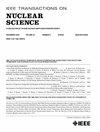Effect of Heavy Ion Radiation on Electrical Performance of AlGaN/GaN HEMTs in Non-Gate Region
IF 1.9
3区 工程技术
Q3 ENGINEERING, ELECTRICAL & ELECTRONIC
引用次数: 0
Abstract
This study employs different types and energies of heavy ions to irradiate AlGaN/GaN high electron mobility transistors (HEMTs), inducing defects with a non-uniform depth distribution in the GaN epitaxial layer beneath the non-gate region. By integrating experimental and simulation approaches, we investigate the variation patterns of the device’s electrical performance as a function of irradiation fluence. Through electrical performance testing and simulations using extreme-environment radiation effect technology computer aided design (ERETCAD) software, it was observed that heavy ion-induced damage is confined to the GaN epitaxial layer beneath the non-gate region, the saturated drain current (重离子辐射对非栅区AlGaN/GaN hemt电性能的影响
本研究采用不同类型和能量的重离子辐照AlGaN/GaN高电子迁移率晶体管(hemt),在GaN外延层非栅区下诱导深度分布不均匀的缺陷。通过实验和模拟相结合的方法,我们研究了器件电性能随辐照强度的变化规律。通过极端环境辐射效应技术计算机辅助设计(ERETCAD)软件对器件的电性能进行测试和模拟,发现重离子诱导损伤局限于非栅区下的GaN外延层,饱和漏极电流(${I} _{\mathbf {ds}}$)随着辐照通量的增加而减小,器件的阈值电压(${V} _{\mathbf {th}}$)保持不变。重离子辐射在GaN层中引入位移缺陷,随着与二维电子气体(2DEG)距离的增加,这些缺陷对载流子的库仑散射效应减弱。因此,通过考虑辐射诱导带电缺陷对载流子的散射效应,改进了传统的非电离能损失(NIEL)值。这种调整导致等效退化现象,其中不同重离子辐照下的${I} _{\mathbf {ds}}$与总有效非电离能沉积(TNID ${}_{\mathbf {effective}}$)相关。
本文章由计算机程序翻译,如有差异,请以英文原文为准。
求助全文
约1分钟内获得全文
求助全文
来源期刊

IEEE Transactions on Nuclear Science
工程技术-工程:电子与电气
CiteScore
3.70
自引率
27.80%
发文量
314
审稿时长
6.2 months
期刊介绍:
The IEEE Transactions on Nuclear Science is a publication of the IEEE Nuclear and Plasma Sciences Society. It is viewed as the primary source of technical information in many of the areas it covers. As judged by JCR impact factor, TNS consistently ranks in the top five journals in the category of Nuclear Science & Technology. It has one of the higher immediacy indices, indicating that the information it publishes is viewed as timely, and has a relatively long citation half-life, indicating that the published information also is viewed as valuable for a number of years.
The IEEE Transactions on Nuclear Science is published bimonthly. Its scope includes all aspects of the theory and application of nuclear science and engineering. It focuses on instrumentation for the detection and measurement of ionizing radiation; particle accelerators and their controls; nuclear medicine and its application; effects of radiation on materials, components, and systems; reactor instrumentation and controls; and measurement of radiation in space.
 求助内容:
求助内容: 应助结果提醒方式:
应助结果提醒方式:


